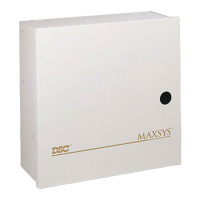Communications Programming
39
SECTION 1 2 3 4 5 6 7 8 9 10 11 12 13 14 15 16
dialer direction settings. If disabled, the panel will fol-
low the programmed backup dialing procedure
(default=No).
• SIA 1 Account #: See 12.6 ‘Communicator Formats‘ for
information.
• Auto Report SIA: See 12.6 ‘Communicator Formats‘
for information.
• Test Tx in Min: If enabled, the test transmission timer
will be in minutes. If disabled, it will be in days. See
10.8 ‘Test Transmissions‘ (default = No).
• Tx Delay in Min: If enabled, the transmission delay
will be in minutes. If disabled, it will be in seconds. See
10.9 ‘Transmission Delay‘ (default = No).
• 2nd Line Flash: If enabled, the panel will use the stan-
dard dialing routing with the following addition. If the
panel doesn’t detect a dial tone during the first five
seconds, the panel will flash the line (hang up and pick
up again) for 90ms. The panel will then search for a
dial tone on the virtual line (default = No).
NOTE: This option is for use in Sweden only. Do not
enable in North America. If this and the LINKS1000
are enabled, the LINKS dialing procedure will be
slightly different. The panel will backup to the LINKS
on the third attempt.
• 6 digit Acct: If enabled, the system and partition
account numbers will be six digits for the SIA format.
If disabled, the account numbers will be four digits
(default=No).
• T-Link Enabled: This option must be set to [N] for a
UL Listed system. If enabled, a communications link
between this product and a receiver, DLS, computer or
other devices on a LAN/WAN will be used.
NOTE: A T-Link module must be connected to the PC-
Link connector on the panel.
Please refer to the T-Link Installation Manual for further
information.
12.5 Dialer Direction
Ref #: [000400XX02] where XX = telephone number 00-02
The Dialer Direction programming section determines
which reporting codes will be sent to which telephone
number. Three groups of reporting codes can be selected:
• alarms and restorals
• openings and closings
• all other miscellaneous codes
These groups can be programmed to communicate to any
or all telephone numbers.
By default, all reporting codes are sent to the first tele-
phone number only. The dialer direction options are tog-
gle options which are either enabled ([Y]es) or disabled
([N]o). Dialer options are programmed individually for
each telephone number. The reporting codes in each
group are indicated in Appendix A ’Reporting Codes’.
12.6 Communicator Formats
Ref #: [000400XX01] where XX = telephone number 00-02
Each telephone number must be assigned a format to
communicate with the central station. There are several
different communicator formats available. The default for-
mat is 20 BPS 2300Hz Handshake.
10 BPS 1400/2300Hz Handshake Formats
• Data = 1900 Hz
• Kissoff = 1400/2300 Hz
• Speed = 10 Baud
20 BPS 1400/2300Hz Handshake Formats
20 Bits Per Second is the standard fast format used on DCI,
Franklin, Sescoa and Vertex receivers.
• Data = 1800 Hz
• Kissoff = 1400/2300 Hz
• Speed = 20 Baud
These formats will send an account code to identify which
customer is sending the alarm, and a reporting code to
identify the type of alarm. Depending on the receiver, the
account code must be either three or four digits, and the
reporting code must be either one or two digits.
If the account code requires only three digits, program the
system ID code and each partition account code with 3
digits, followed by a [0]. If you wish to send a zero in the
account code, program it with a HEX A. For example, to
program account code 103 enter ’1A30’.
If the reporting code needs to be only one digit, program
the second digit as a [0]. For example, to program a report-
ing code as ’3,’ enter ’30’. To send a zero, program HEX A
into the reporting code. For example, to send reporting
code ’30,’ program ’3A’.
For instructions on programming HEX digits, see 3.4 ‘Pro-
gramming Hexadecimal Data‘.
Contact ID
Contact ID is a specialized format that will communicate
information using tones rather than pulses. This format
allows more information to be sent faster than other for-
mats. For example, in addition to reporting a Zone 1
alarm, the Contact ID format can also report the type of
alarm, such as an Entry/Exit alarm.
To program Contact ID, a 2-digit number from Appendix
A must be entered for every event to be transmitted. The
2-digit number determines the type of alarm. The panel
will automatically generate all other information, includ-
ing the zone number.
Additional Notes on Contact ID
1. Account Numbers must be four digits.
2. All reporting codes must be two digits.
3. Substitute the HEX digit ’A’ for the zero (0).
4. To prevent the panel from reporting an event, the
reporting code should be programmed as [00] or [FF].
Please refer to Appendix A ’Reporting Codes’ and Appen-
dix B ’Zone Reporting Codes’ for a list of suggested Con-
tact ID Identifiers for each event.
Auto-Contact ID
Ref #: [000401] and scroll to option
When programmed, the Auto-Contact ID automatically
generates the Contact ID reporting codes for all events.
Program [00] to disable the event from reporting.
NOTE: Several fire related reporting codes are set to 99
by default to ensure they are transmitted. If using Con-
tact ID, these code need to be reprogrammed. See
Appendix A for the specific codes.

